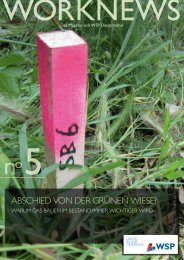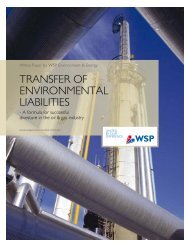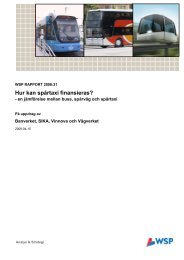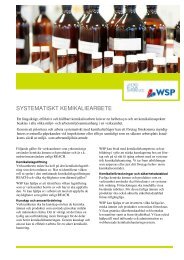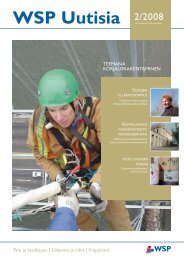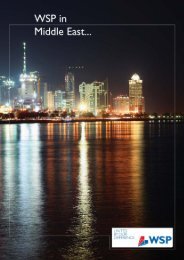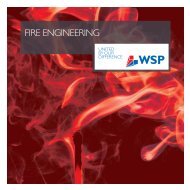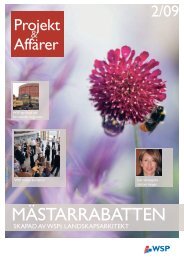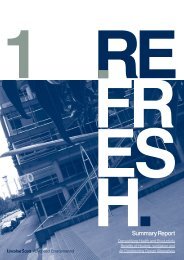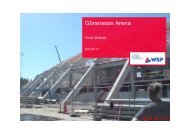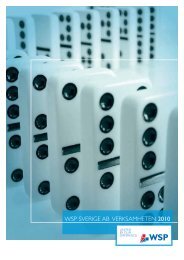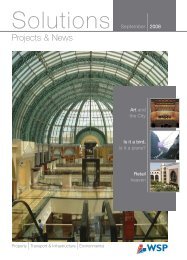We are pleased to present this book which showcases ... - WSP Group
We are pleased to present this book which showcases ... - WSP Group
We are pleased to present this book which showcases ... - WSP Group
You also want an ePaper? Increase the reach of your titles
YUMPU automatically turns print PDFs into web optimized ePapers that Google loves.
78<br />
ENVIRONMENTAL<br />
Terminal 5 Heathrow Airport, UK<br />
ENVIRONMENTAL SUCCESS STORY FOR NEW AIRPORT TERMINAL<br />
Terminal 5 (T5) at Heathrow Airport is one of Europe’s largest<br />
construction projects of the 21st Century.When fully complete<br />
it will provide Heathrow Airport with the capacity <strong>to</strong> handle up <strong>to</strong><br />
35 million additional passengers annually.When T5 opens in 2008,<br />
its design and construction will set new standards in environmental<br />
performance, an achievement in <strong>which</strong> <strong>WSP</strong> has played a major part.<br />
The public inquiry in<strong>to</strong> T5 was the longest in UK planning his<strong>to</strong>ry,<br />
lasting nearly four years.The inquiry set down almost 700 conditions,<br />
many of <strong>which</strong> related <strong>to</strong> the responsible management of the<br />
terminal’s environmental impacts during construction and operation.<br />
Balancing environmental and commercial aw<strong>are</strong>ness<br />
<strong>WSP</strong> was commissioned <strong>to</strong> assist in managing the environmental<br />
aspects of the project, working jointly for British Airways (BA) –<br />
the airline that will operate from T5 – and airport owner BAA.<br />
In developing the design brief it was necessary <strong>to</strong> ensure that<br />
throughout the design, construction and operational phases the<br />
project would meet both the high environmental standards required<br />
by the public inquiry and the stringent operational requirements of<br />
both organisations.<br />
To achieve <strong>this</strong>,<strong>WSP</strong> developed and managed the environmental<br />
management system (EMS) for the design work and the construction<br />
phase of the project, working in alignment with BA’s and BAA’s own<br />
emerging EMS programmes.This work involved complex negotiations<br />
with both organisations, each of whom had their own aspirations and<br />
business drivers, and hence EMS requirements.<br />
As part of <strong>this</strong>,<strong>WSP</strong> helped <strong>to</strong> establish an environmental design<br />
review process, <strong>which</strong> involved management of internal and external<br />
stakeholder engagement <strong>to</strong> enable the design <strong>to</strong> be progressively<br />
developed and signed off at each critical stage by both clients and<br />
stakeholders.<strong>We</strong> set up design expert groups, using both project<br />
specialists and external advisors, who were world leading designers,<br />
engineers and environmentalists, <strong>to</strong> verify the work of the design<br />
teams.This process was crucial in enabling the overall design of <strong>this</strong><br />
complex project <strong>to</strong> be progressed in alignment with the public<br />
inquiry commitments and ensuring that design solutions were<br />
optimised technically and commercially.<br />
Contribution <strong>to</strong> overall project success<br />
A key focus of the work was <strong>to</strong> ensure that the handling of all<br />
environmental issues contributed positively <strong>to</strong> the overall success<br />
of the project at all stages.<br />
For example, an early challenge was <strong>to</strong> supervise a revised<br />
environmental impact assessment (EIA) planning application for the<br />
diversion of the ‘twin rivers’ <strong>which</strong> run across the site.There had<br />
been problems with the initial EIA submitted <strong>to</strong> the planning inquiry<br />
by another environmental consultancy, and <strong>this</strong> work was undertaken<br />
<strong>to</strong> a very tight schedule during the early enabling works phase <strong>to</strong><br />
allow the construction phase <strong>to</strong> commence on time.<br />
One of the most successful environmental s<strong>to</strong>ries for T5 was the<br />
water saving measures that were achieved within the design. 70%<br />
of water demand in the buildings will be from non potable sources.



